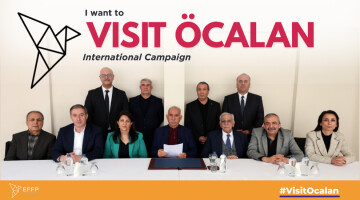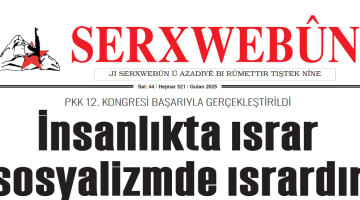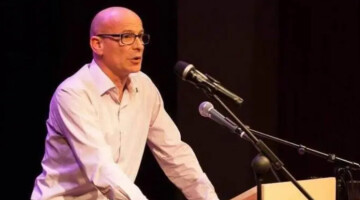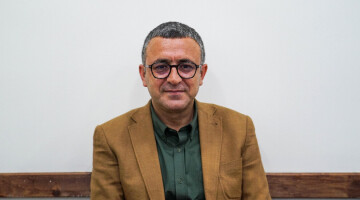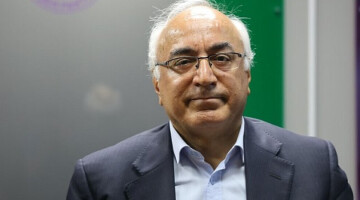Saturday Mothers/People have been holding a sit-in protest in Istanbul Galatasaray since 1995. This action, which has recently passed the 1000th week, has come under a lot of pressure. In fact, most recently, the AKP-MHP governments closed the square with police barriers. Relatives of the disappeared people were violently detained many times. Even though they were allowed to make a statement, the square was not open. The only day the square was opened was the 1000th week. AKP Group Deputy chair Özlem Zengin said that they would open the square as if it were a blessing, but then she added: "We will not allow this to be abused." As a matter of fact, it happened as Özlem Zengin said. After the 1000th week commemoration, which saw large participation, the square was again surrounded by police barriers. But the Saturday Mothers/People continue their struggle despite all the barriers.
Bîr (The Well) is a documentary shot in 2018 by director Veysi Altay, who has witnessed this struggle for many years and made cinema and photography works about the disappeared. The movie is still very relevant and tells the story of 7 people who were forcibly disappeared in Kerboran (Dargeçit) in the 90s.
ANF spoke to director Altay about his work as well as about recording the struggle of the relatives of the disappeared.
The struggle of Saturday Mothers/People has just celebrated its 1000th week and continues. First of all, how did the shooting phase of your documentary begin?
Frankly, it started a long time ago, because I have also been an activist on the issue of disappearances since 2000. I worked in the field of human rights for a long time in the Human Rights Association, Istanbul and Ankara branches. I was already personally involved in the issue. I have been taking photographs to create an archive for a long time because we have a lot of social events, but, unfortunately, we all have serious deficiencies in archiving completely, creating a memory, and carrying something to the future. To be honest, I was collecting some photos and stories to fill the gaps in this regard. Then I did photographic work from the photographs I took until 2010. It was a photo album called The Lost Us based on 100 photographs and 100 stories.
Then, I made a documentary called Perpetrator State about the disappeared people. It also told the stories of people who disappeared and were murdered in the years 90-95 in Cizre, and it was published in 2012. During the same period, I was preparing the documentary about Mother Berfo, and I finished it around 2015. I focused on the disappeared people of Kerboran after 2015.
In fact, you were both involved in the issue and in a place that created memory...
Yes. Of course, all of these were my focus when I was working on the disappeared people. As a whole, it's like creating archives, taking photographs, collecting stories. At that time, after finishing the documentary about Mother Berfo, I started the documentary Bîr (The Well). I actually started it in 2010. On the other hand, I was following Hazni Doğan, Seyhan Doğan's brother, and mother Hediye, who were lost in Kerboran. I often went to their homes for interviews and meetings. There was already a trial at that time.
Of course, when you started, the disappeared people hadn't been found yet, right?
Correct. When we started this work, none of those disappeared had been found. Frankly, no one had any hope that they would be found. During that process, when I started the interviews and talks, I was going back and forth to both Kerboran and to mother Hediye, since she lived in Kanarya, Istanbul. Then, during that process, as a result of the confessions of an informer, the opening of courts and the determination of places, various information about the facts emerged. At that time, the families' lawyers applied to the Kerboran prosecutor's office at the time and also to the Amed prosecutor's office. The informers provided information, so petitions were filed demanding to re-investigate those disappearances, and open the places mentioned by those informers in accordance with the Minnesota Protocols, and to reach the bones of those people. Then a lawsuit was filed and Kerboran Prosecutor's Office later made a decision to open some of the places shown. During that opening process, that is, on the date given regarding the places where the graves would be opened, we went to Kerboran with our friends and families from the Human Rights Association. The prosecutor's office and some police officers, of course, started digging some places with bulldozers, something completely against the Minnesota Protocols. Of course, nothing came of it at that time. On the same day, there were a lot of families. We visited some places in that village to see what was going on, because there were also rumors about that village.
What were those rumors?
That village was under the control of the army there for a while, and people said that many people were tortured, killed or disappeared in that village. There were also many water wells in those two villages. A lot of people were probably killed and thrown into those wells. We visited some wells and noticed that there were things there that did not belong to those wells. We started digging wells with families. When we say digging, we started to remove stones, accumulated garbage, etc. After a while, some human clothes and some personal belongings were found in a well. In fact, Kerboran Municipality was run by the HDP at that time. Families called, and the municipality came immediately. We drained that well for hours and found a few bones there. Of course, the lawyers there said that there would be a legal problem if these bones were removed by us, because they should be removed with the help of the prosecutor's office. An application was made to the prosecutor's office, and then the excavation was carried out again. The remains of Seyhan Doğan and Emin Aslan were found there at that time. Of course, we didn't know who those remains belonged to at that time, but later the identities were confirmed. The body of one of the 7 people who disappeared in the same period was found in a well in 1996. Six people were missing, 2 of them were later found in Qoser, 150-200 km away from where the incident took place. Then, the bodies of Nedim Akyon and Davut Altunkaynak were found in a cave close to their village. In 2013, 2014 and 2015, bodies were removed two by two from various caves and wells at one-year intervals. We followed that whole process. I shot it and recorded it, and that’s how the movie came out.
From 2018 to the present, Galatasaray square has been banned for a long time. It was only opened for the 1000th week. Then it was closed again. As someone who has been continuing and recording the struggle of the relatives of the disappeared for a long time, how do you evaluate the closure of the square?
Frankly, the issue of disappearances is not just an issue for Turkey. Many countries, like Guatemala, Chile, Argentina, Salvador, Spain during the Franco period, have witnessed forced disappearances. All states use the same methods, disappear and summary execute people... Some countries engage in a partial confrontation with this reality, while some countries implement a policy that rejects it completely. Turkey is at a point where it completely rejects this issue rather than confronting it. For a while, the AKP started to give messages that we would partially confront the reality of the forced disappearances. In fact, that period corresponded to 2012-2013-2014.
As I said at that time, many bodies, many cemeteries and graves were opened, and bones were found in ways not allowed by the Minnesota Protocol. Some of the bones were later covered up, saying they were animal bones. In fact, forensic medicine, as another institution affiliated with the state, tried to cover up a crime committed by the state. Because there is no independent forensic medicine or institutions that can investigate this independently in Turkey.
No results were obtained from the trials, anyway...
In fact, rather than confronting this reality, the government somehow exonerated the people who committed murder in the name of the state, and disappeared people while in security forces custody. The state actually protected its own murderer until the end. They were already protected in the past. Cemal Temizöz received nearly 127 awards from the state for the many murders he committed in Cizre or the many people he killed or disappeared. Musa Çitil was someone who played a very serious role in the disappearance of 11 villagers in Mardin and was later reappointed as the operation commander of Sur.
Mehmet Ağarlar, Sedat Bucaklar, Arif Doğanlar, to name a few, were all not punished. Many lawsuits were filed against all of them, but they were all acquitted.
Of course, even the raising of the voice by families and relatives, their quest for justice, and their ability to reach people is something that seriously disturbs the government. First, those murderers were acquitted in all courts. Then Galatasaray Square was banned and people acted as if such a problem did not exist in Turkey or as if it was very individual. This is a reflection of the state's 100-year-old official policy.
If someone goes beyond the point set by the state as a ‘red line’, they will be subjected to the repression of the state again, will be banned again, will go to prison again, will be detained again. The AKP government came with the intention of confronting Turkey's past. But in the past, he cooperated and collaborated with all the murderers who did dirty work in Turkey. Today, they support all crimes against humanity or all genocides or massacres that took place in the past, and anyone who opposes this is a potential enemy for them. That's why banning it is not such a light situation.
Maybe the government can ban the Saturday Mothers from now on too. But this ultimately does not interrupt the struggle these mothers have been waging since 1995. This is not a threat that will force any of us to step back on this issue. When the Saturday Mothers and their people first came to Galatasaray in the 90s, they were severely tortured, dragged to the ground, beaten, detained and thrown into prison. But since 1995, those people and their grandchildren and children are still in search of justice. It's not something that only happens in Istanbul and Galatasaray. These people are in front of Cizre High School, in Amed, Koşuyolu, Batman, Urfa. Because we are talking about nearly ten thousand state-perpetrated murders and state-perpetrated disappearances in Kurdistan. At least those people are trying to get justice for those killings.
We need to look at this issue from our own perspective: What can we do more competently and effectively on this issue? How can we strengthen this struggle? I do this with cinema, someone else can do it with photography or an article they write. Because this is one of the most important issues of Turkey and Kurdistan. Because it is an endless mourning. These are lives left between life and death. In other words, the dead do not die because they are missing, and the living do not live because their relatives are missing. If there is to be talk about normalization, peace or a non-conflict environment, this issue must be resolved.





